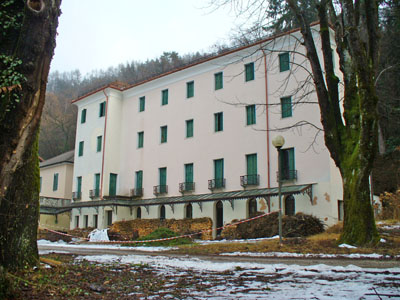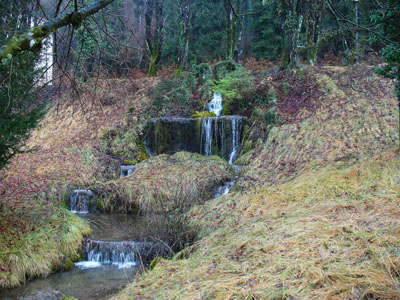| Card n. | Description | Locality | Linked sites |
| 46 | Vena d'Oro | Ponte nelle Alpi | 4 |
| file .pdf | Architecture Art History (ASA) | Google maps |
 |
 |
- Description
- How to get there
- Interesting facts
- Bibliography
On the left side of the river Piave, at about 450 m a.s.l., right next to Nevegal hill, there is an area crossed through by copious spring waters, renowned for their therapeutical properties since the fifteenth century, and it is even believed that much earlier, in Roman times, there was a spa facility here serving the municipium of Belluno. In the second half of the nineteenth century, between the little villages of Cugnan and Sagrogna, on the border between the municipalities of Ponte nelle Alpi and Belluno, the water of the Vena d’Oro was channelled into an elegant spa facility, which was completed by a hotel, park and a small Neo-Gothic church. In 1869, Cav. Giovanni Lucchetti ordered extension work to be carried out on the former convent of the friars of San Pietro, turning it into what was for thirty years to be a leading, exclusive climatic resort. The therapy itself was combined with a range of complementary activities, such as concerts in the park, excursions, pheasant hunting trips, riding trips, balls and rafting trips along the Piave to Mel, aimed at a Central European clientele that included Queen Margherita di Savoia. After WWI the Vena d’Oro was left off the new tourist track, as a result of the damage it suffered during the war, and most of it was purchased by the SADE electricity company, which in 1938 inaugurated a holiday camp there for the children, created using the buildings of the former spa complex.
From the A27 motorway exit for Belluno, continue until the roundabout at the bridge over the Piave, and take the third exit towards Lastreghe; after Lastreghe, continue along the flat road until a fork in the road, from where you can see a building (ex Vena d’Oro) on the left. At the crossroads, go up towards the left, where you can see the various buildings of the former spa complex.
ACCESSIBLE: from the outside; visits possible on request in loco
MUNICIPALITY: Ponte nelle Alpi
PLACE: Vena d’Oro
GEOGRAPHICAL COORDINATES: X 1752741 – Y 5116218
PROVINCE: Belluno
FILE COMPILED BY: Bonato/Vedana
In the neighbourhood of Camana, in Via Cernidor, opposite the former Vena d’oro spa complex, along a pleasant valley crossed by the cool, sometimes rushing waters of the Cavalli brook, a number of buildings can be spotted lying in a state of abandon amid the thick vegetation. In the past, these five buildings were used for milling and fulling fabric, and there is ample documentary evidence of such activity dating back to the 16th century, mentioned in the archives until the nineteenth century. The sixteenth-century documents refer to two “mills with three wheels and a husk crusher”, and to “a fulling plant for large stretches of cloth”, belonging first to a certain Bastian from Camana and then to the Bertagno family. The husk crusher, or panizzo was a tool used to remove the kernel of the panic, a type of grass seed similar to millet, from the husk, while the fulling machine was used to finish off the woollen fabrics in such a way as to make them more hard wearing. The fulling process was carried out using hydraulic machines equipped with large hammers that beat the cloth, wrapped in a roller, so that the fibres were pressed tightly together. After this operation, the cloth was spread over the chiodere, or trellises, to dry. This is why fulling plants had to be built in places where there was plenty of open space outside. As late as the nineteenth century we know that in Camana there was still a “workshop for fulling and dyeing cloth”.
R. Padovani, Una gita a Capodiponte. Breve storia dello stabilimento idroterapico climatico “La Vena d’oro”, Grafiche Longaronesi, Longarone-Ponte nelle Alpi (Belluno), 1997

